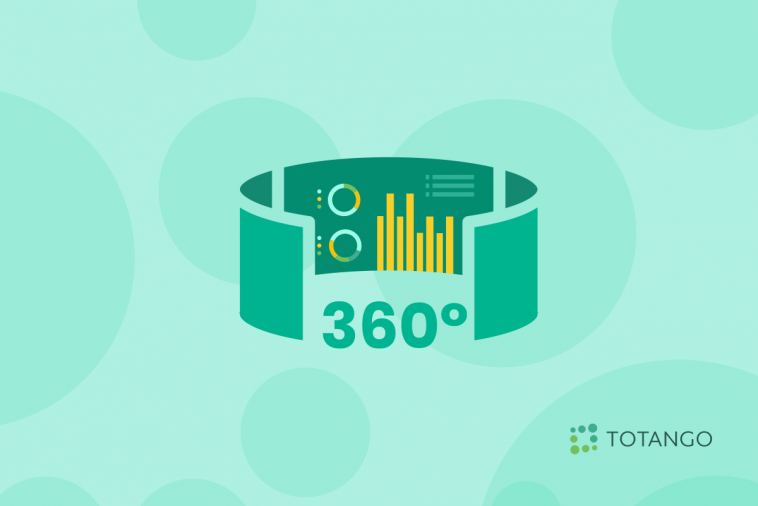- Like
- SHARE
- Digg
- Del
- Tumblr
- VKontakte
- Flattr
- Buffer
- Love This
- Save
- Odnoklassniki
- Meneame
- Blogger
- Amazon
- Yahoo Mail
- Gmail
- AOL
- Newsvine
- HackerNews
- Evernote
- MySpace
- Mail.ru
- Viadeo
- Line
- Comments
- Yummly
- SMS
- Viber
- Telegram
- JOIN
- Skype
- Facebook Messenger
- Kakao
- LiveJournal
- Yammer
- Edgar
- Fintel
- Mix
- Instapaper
- Copy Link
Today’s consumers have higher expectations for the companies they work with than ever before. The digital business landscape has made it so competitors can easily reach out to prospective customers with offers of enticing deals and promises of attentive service. As a result, if a user isn’t fully satisfied with their service, switching providers can be done in a day’s time.
To prevent these churn-centered scenarios, organizations are increasingly turning to platforms like Totango to engage customers on a personalized level that their rivals can’t match.
What is Customer 360?
Customer 360 enables a complete look into the health of all your customers by aggregating important data into one central location. With this feature, you can examine a number of insightful metrics and segment your client base for an optimized customer journey that surpasses what the competition can offer.
The specialty of Customer 360 is creating a real-time picture of customer health across your entire user base. As clients move from onboarding to renewal, this real-time view allows CS teams to take action quickly when customer health scores fluctuate.
What Goes Into a Real-Time Customer 360 View?
Customer 360 creates a holistic view of client health by pulling from a variety of data sources. These data sources are aggregated into a scorecard that shows the state of your client base, where they are in the customer journey, whether they are using your products, how engaged they are, and if they are willing to recommend your business to others.
Amongst these different data sources, Customer 360 accesses:
- Support tickets
- Feedback metrics like NPS and CSAT scores
- Financial data
- Product usage and adoption metrics
- Sales history
- CSM Sentiment
- Touch points
With the context provided by these data sets, your enterprise can make informed decisions on how to engage with customers in a personal, proactive manner.
Goals and KPIs
Customer 360 enables you to measure success for both your customers and your business. Surface insights show how your customer base is doing in their customer journey, where they are at in their lifecycle, and what their levels of usage and engagement are. Tracking key KPIs regarding customer health and your team’s activities is also valuable, as these metrics give you an even more comprehensive picture of how your customers and team members are progressing towards goals.
So what kind of insights can you get from Customer 360? Here are just a few examples:
Surface Customer Insights
- Number of Accounts
- Total Contract Value
Monitor Customer Health and Engagement
- Average Active Days
- Monthly Active Users
Monitor Team Activities
- Accounts with Open High Priority Tickets
- Account Coverage
This allows for a deeper understanding of who your customers are and informs both when and how they can best be engaged. Equipped with this knowledge, CS teams can create more opportunities for upsells/expansions, as well as reduce churn rates.
Why CRM Data Visualization is Not Enough
CRM data visualization is not enough—merely providing a comprehensive view of the customer is insufficient. While having lots of data can be helpful, if you are not doing anything with the data it’s useless. The emphasis needs to shift to translating data into outcomes and guiding your team in real-time. Technology can help the decision-making process by suggesting actionable next steps based on the data provided.
Here are some CRM shortcomings:
- Requires you to build the process from scratch
- Doesn’t leverage the latest best practices
- No true “customer health score” offered
- Missing predictive capabilities
- Difficult to share data in context with the team without needing a meeting
- More costly—it requires certified administrators dedicated only for CS or a team of data scientists
- If you are relying on a data scientist to distill a new report, it could be a month by the time you get it—by then, the data is too old to be truly relevant
“Relying on CRM for a broad understanding of account health and renewal likelihood will only paint a small part of the picture, and TSIA recommends investing in “best of breed” customer success technology to more accurately assess account health, automate recurring revenue, and fully explore the customer experience. – Phil Nanus, VP of Customer Success Research at the Technology and Services Industry Association (TSIA)“
Using Customer 360 to Improve Customer Success
By using Customer 360, your enterprise will have a full picture of the state of its client base. The real-time view enables you to stay aware of any changes in individual clients, alerting you to any significant shifts in usage, goals, or expectations. The capability to view aggregated information about all your customers in one place facilitates personalized engagement with clients and the ability to view and act on feedback.
Personalized Engagement With Clients
Customer 360 provides visibility into how each account is doing across the customer journey. As you see how clients progress over time, you will gain a deep understanding of how they use your product to achieve value. From there, you can leverage this data to anticipate customer needs and improve product adoption.
| Example: A large number of customers are reaching a high product threshold. You can take this opportunity to target these customers with a digital campaign that highlights the latest sales promotions. You may also want to have them schedule time with your team to discuss their account activity and review pricing options for upgrades or complementary solutions. Conversely, if their activity levels drop, your team can take proactive action to avoid churn. |
View and Act on Feedback
Both tracked by Customer 360, Net Promoter Scores (NPS) and Customer Satisfaction Scores (CSAT) are metrics that reveal how a customer feels about your product. NPS relates how likely a customer is to recommend your service to a colleague, while CSAT rates how satisfied the client is with the product itself.
| Example: Detractors or dissatisfied customers can now be easily identified and receive automated follow-ups with the appropriate team member to dig deeper into their situation and develop a plan to get them back on track. In the case where these scores are very positive, you can look towards these clients for possible upsell opportunities. As your team enacts these efforts, Customer 360’s up-to-date account coverage keeps you knowledgeable on the results, enabling any pivots as necessary. |
Set Your CS Team Up for Success with Customer 360
Customer 360 is what can give your company an advantage over the competition. Totango offers Customer 360 as a SuccessBLOC, meaning it’s a modular framework filled with goals, metrics, and action plans specifically designed for each stage of the customer journey. Make sure to check it out to get a detailed overview of your customer base, drive predictive customer success, create more personalized customer engagements, foster loyalty, prevent churn, and create value by identifying and delivering what your clients need to succeed.
Totango’s Customer 360 SuccessBLOC enables a comprehensive understanding of your customer base, allowing you to deliver an enhanced customer experience. In these challenging times, you can’t afford to buy before you try. Get started for free today.



